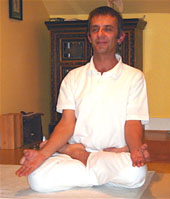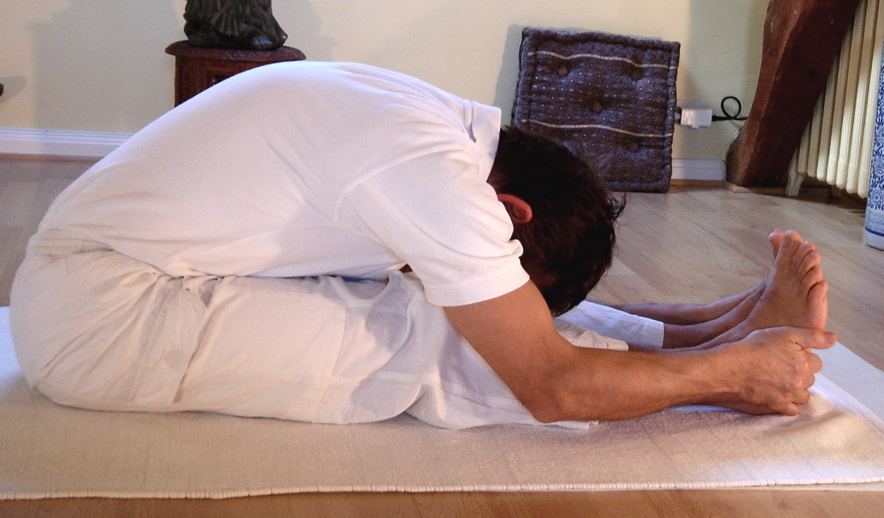 |
| Padmasana - Lotus Pose Joseph RENGER, CC BY-SA 3.0, via Wikimedia Commons |
Aging is a beautiful yet challenging process. As we grow older, our bodies undergo natural changes—muscle strength decreases, flexibility reduces, and joints may stiffen.
Many seniors also struggle with balance, mobility, or chronic health conditions such as arthritis, diabetes, or hypertension. While these challenges are normal, they need not prevent seniors from enjoying an active and fulfilling life.
One of the most effective, gentle, and accessible practices to support healthy aging is yoga.
Yoga is not merely a physical exercise; it is a holistic practice that integrates body, mind, and breath. For seniors, yoga provides several benefits: improved flexibility, reduced joint pain, better balance, enhanced breathing, stress relief, improved sleep, and an overall sense of calmness. The beauty of yoga lies in its adaptability—it can be modified to suit all ages and fitness levels.
For senior citizens, the goal of yoga is not about pushing the body into complex postures but rather about cultivating mobility, relaxation, and mindfulness. Even the simplest yoga postures, when practiced consistently, can bring profound improvements in health and quality of life.
In this essay, we will explore ten easy yoga postures for seniors, each explained step-by-step, along with their benefits, modifications, and safety precautions. Each posture is narrated in detail to make it clear, approachable, and safe for older adults.
1. Tadasana (Mountain Pose)
 |
| Tadasana - Mountain Pose Hindisign, CC BY-SA 4.0, via Wikimedia Commons |
How to Do Tadasana:
-
Stand upright with feet together or slightly apart (hip-width is comfortable for seniors).
-
Distribute weight evenly across both feet.
-
Keep your spine tall, shoulders relaxed, and arms resting naturally beside your body.
-
Engage the thighs slightly and lift the kneecaps gently.
-
Inhale deeply, raising your arms overhead with palms facing each other.
-
Stretch upward as if reaching for the sky while keeping heels firmly on the floor.
-
Hold for 20–30 seconds, breathing slowly. Exhale and release arms.
Benefits for Seniors:
-
Improves balance and stability, reducing fall risk.
-
Corrects posture by lengthening the spine.
-
Enhances circulation and breathing capacity.
-
Provides a gentle way to strengthen the legs without strain.
Modifications:
Seniors can hold onto a chair or wall for support if balance feels shaky. The arms can remain at the sides instead of raised if shoulder mobility is limited.
Precautions:
Avoid locking the knees. Keep movements slow and mindful to prevent dizziness.
2. Vrikshasana (Tree Pose, with Chair Support)
 |
| Tree Pose Plankfad, CC BY-SA 4.0, via Wikimedia Commons |
How to Do Vrikshasana:
-
Stand tall in Tadasana. Place a chair nearby for support.
-
Shift weight onto the left leg, keeping it firm and straight.
-
Lift the right foot slightly and place it either on the ankle or calf of the left leg. (Avoid placing it on the knee.)
-
Use the chair for balance if needed.
-
Bring palms together at the chest in a prayer position or raise arms overhead if comfortable.
-
Hold for 10–20 seconds, focusing on a point ahead.
-
Slowly release and switch sides.
Benefits for Seniors:
-
Improves balance and coordination, reducing the risk of falls.
-
Strengthens legs, ankles, and core muscles.
-
Enhances concentration and mental focus.
-
Encourages a sense of grounding and calm.
Modifications:
Keep toes of the lifted foot touching the floor for added support. A wall or chair can be used throughout for balance.
Precautions:
Those with severe arthritis or hip issues should keep the lifted leg low and avoid forcing the knee outward.
3. Bhujangasana (Cobra Pose – Gentle Version)
Bhujangasana, or Cobra Pose, is a gentle backbend that strengthens the spine and opens the chest. For seniors, it is a wonderful posture to improve spinal flexibility, alleviate back stiffness, and encourage better breathing.

Bhujangasana - Cobra Pose
Iveto, CC BY-SA 4.0, via Wikimedia Commons
How to Do Bhujangasana:
Iveto, CC BY-SA 4.0, via Wikimedia Commons
-
Lie down on your stomach on a yoga mat.
-
Place palms under the shoulders, elbows close to the body.
-
Inhale and slowly lift the head, chest, and shoulders off the floor.
-
Keep the pelvis and legs grounded.
-
Lift only as high as comfortable—this is not about straining but gently stretching.
-
Hold for 10–15 seconds with steady breathing.
-
Exhale and slowly lower down. Repeat 2–3 times.
Benefits for Seniors:
-
Strengthens the back muscles and spine.
-
Relieves stiffness in the shoulders and neck.
-
Expands the chest and improves lung capacity.
-
Stimulates abdominal organs, aiding digestion.
 |
| Christy Collins, photographer, CC BY-SA 3.0, via Wikimedia Commons |
Modifications:
Instead of lifting high, seniors can do a Sphinx Pose variation: rest on forearms with elbows under shoulders, lifting the chest gently.
Precautions:
Avoid if suffering from severe back pain, hernia, or recent abdominal surgery. Move slowly and never force the back.
4. Setu Bandhasana (Bridge Pose – Supported)
 |
| Bridge Pose Joseph RENGER, CC BY-SA 3.0, via Wikimedia Commons |
Setu Bandhasana, or Bridge Pose, is an excellent posture for strengthening the back, glutes, and legs. It also promotes relaxation and opens the chest. For seniors, it can be performed gently, even with props for support.
How to Do Setu Bandhasana:
-
Lie on your back with knees bent and feet flat on the floor, hip-width apart.
-
Place arms alongside the body, palms facing down.
-
Inhale, pressing feet into the floor as you slowly lift hips upward.
-
Keep shoulders grounded and chin tucked slightly.
-
Hold for 10–20 seconds, breathing deeply.
-
Exhale and gently lower hips back down. Repeat 2–3 times.
Benefits for Seniors:
-
Strengthens back, hips, and thighs.
-
Improves spinal flexibility and posture.
-
Opens the chest, improving breathing.
-
Relieves mild stress and fatigue.
Modifications:
Place a yoga block, cushion, or bolster under the lower back for Supported Bridge Pose, which allows seniors to relax without strain.
Precautions:
Avoid if suffering from severe knee, hip, or spinal injuries.
5. Marjaryasana–Bitilasana (Cat-Cow Stretch)
 |
| Bitilasana English: Mary O'Neill, Public domain, via Wikimedia Commons |
How to Do Cat-Cow:
-
Start on hands and knees with wrists under shoulders and knees under hips.
-
Inhale, arch the back, lift the head and tailbone upward (Cow Pose).
-
Exhale, round the spine, tuck the chin to the chest (Cat Pose).
-
Continue for 5–10 gentle rounds, synchronizing breath and movement.
Benefits for Seniors:
-
Increases spinal flexibility and mobility.
-
Relieves stiffness in back and neck.
-
Improves coordination of breath with movement.
-
Promotes relaxation and reduces stress.
Modifications:
If getting on the floor is difficult, seniors can practice Seated Cat-Cow while sitting on a sturdy chair.
Precautions:
Move slowly and avoid over-arching if suffering from spinal issues.
6. Baddha Konasana (Butterfly Pose)
 |
| Baddha Konasana Joseph RENGER, CC BY-SA 3.0, via Wikimedia Commons |
How to Do Baddha Konasana:
-
Sit on the floor with legs extended.
-
Bend the knees and bring soles of the feet together.
-
Hold the feet with both hands and let knees drop gently toward the floor.
-
Sit tall and breathe deeply, holding for 20–30 seconds.
Benefits for Seniors:
-
Improves hip and groin flexibility.
-
Stimulates abdominal organs and digestion.
-
Promotes relaxation in the lower body.
-
Helps relieve fatigue.
Modifications:
Sit on a cushion to elevate hips. Place pillows under thighs for support.
Precautions:
Avoid forcing knees down if hips are stiff or arthritic.
7. Shavasana (Corpse Pose – with Props)
 |
| Shavasana - Corse Pose Joseph RENGER, CC BY-SA 3.0, via Wikimedia Commons |
Shavasana is the ultimate relaxation posture, allowing the body and mind to rest deeply. For seniors, it helps reduce stress, improve sleep, and encourage mindfulness.
How to Do Shavasana:
-
Lie flat on your back with arms at sides, palms facing upward.
-
Keep feet slightly apart and close eyes.
-
Breathe naturally, allowing the body to relax completely.
-
Stay for 5–10 minutes.
Benefits for Seniors:
-
Promotes deep relaxation and stress relief.
-
Lowers blood pressure and heart rate.
-
Improves sleep quality.
-
Enhances mental clarity.
Modifications:
Place a cushion under the knees for back comfort. If lying down is uncomfortable, seniors can practice a Chair Shavasana by reclining in a chair with eyes closed.
Precautions:
Ensure a quiet, safe environment to prevent discomfort.
8. Pawanmuktasana (Wind-Relieving Pose – Gentle)
| Wind-Releasing Pose Flora-Victoria, CC0, via Wikimedia Commons Hatha Yoga, Pawanmuktasana |
This simple posture aids digestion, reduces bloating, and relieves lower back tension—common issues among seniors.
How to Do Pawanmuktasana:
-
Lie on your back with legs extended.
-
Bend one knee and bring it toward the chest.
-
Hug the knee gently with both hands.
-
Hold for 10–20 seconds, breathing deeply.
-
Release and switch sides.
-
Optionally, hug both knees to chest for a fuller stretch.
Benefits for Seniors:
-
Aids digestion and reduces gas.
-
Relieves tension in lower back.
-
Stretches hips and thighs gently.
-
Calms the mind and reduces fatigue.
Modifications:
Perform one leg at a time for ease. A cushion under the head provides neck support.
Precautions:
Avoid if suffering from hernia, recent surgery, or severe spinal conditions.
9. Balasana (Child’s Pose – with Pillow Support)
 |
| Child's Pose - Balasana UmaPrykhodko, CC BY-SA 4.0, via Wikimedia Commons |
Child’s Pose is a gentle resting posture that calms the mind and relieves tension in the back and hips.
How to Do Balasana:
-
Kneel on the floor, big toes touching, knees apart.
-
Sit back on the heels and fold forward, stretching arms in front.
-
Rest forehead on the mat.
-
Stay for 20–30 seconds with deep breathing.
| Child's Pose - Balasana Iveto, CC BY-SA 4.0, via Wikimedia Commons |
Benefits for Seniors:
-
Stretches back, hips, and thighs.
-
Relieves fatigue and calms the mind.
-
Promotes relaxation and reduces stress.
-
Helps release tension in the body.
Modifications:
Place a pillow or bolster under the torso for support. Seniors with knee issues can practice a Seated Forward Fold instead.
Precautions:
Avoid if knees are severely arthritic or replaced.
10. Seated Forward Bend (Chair-Assisted)
 |
| Seated Forward Bend, Joseph RENGER, CC BY-SA 3.0, via Wikimedia Commons |
This posture gently stretches the spine and hamstrings, calming the nervous system.
How to Do Seated Forward Bend:
-
Sit tall on a chair with feet flat.
-
Inhale deeply, lengthening the spine.
-
Exhale and slowly fold forward, letting arms hang down toward the floor.
-
Hold for 20–30 seconds, breathing deeply.
-
Inhale and return to upright.
Benefits for Seniors:
-
Stretches spine and hamstrings.
-
Improves circulation.
-
Promotes relaxation and stress relief.
-
Helps reduce fatigue.
Modifications:
Keep a cushion on the lap and rest arms/head on it for support.
Precautions:
Avoid forcing the fold, especially with back or hip issues.
Conclusion: Embracing Yoga in the Golden Years
For seniors, yoga is more than exercise—it is a gentle companion that nurtures body, mind, and spirit. The postures discussed above—Tadasana, Tree Pose, Cobra Pose, Bridge Pose, Cat-Cow, Butterfly Pose, Shavasana, Wind-Relieving Pose, Child’s Pose, and Seated Forward Bend—are safe, effective, and easy to adapt. Each brings unique benefits, from improving balance and flexibility to reducing stress and enhancing digestion.
The key is consistency. Just 15–20 minutes of daily practice can make a noticeable difference in energy, mood, and mobility. Seniors should listen to their bodies, practice at their own pace, and use props or support when needed. Consulting a healthcare provider before beginning is also wise, especially if there are existing health conditions.
Yoga for seniors is not about perfection but about gentle movement, mindful breathing, and inner peace. With practice, seniors can enjoy healthier joints, calmer minds, and more fulfilling golden years.